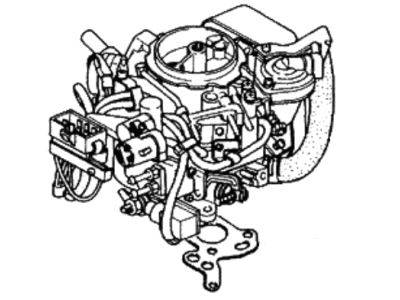If your vehicle's engine is hard to start or does not start at all, has an unstable idle or poor driveability and you suspect the carburetor is malfunctioning, it's best to take the vehicle to a dealer service department with the necessary Feedback Carburetor equipment for diagnosis. The following procedures are intended to help the home mechanic verify proper operation of components, make minor adjustments, and replace some components, but are not troubleshooting procedures. Idle mixture adjustment requires an infrared gas analyzer, which should be performed by a dealer service department or properly equipped repair facility. Inspect the vacuum hoses and idle-up control solenoid harness for proper connections, and check the idle-up actuator hose for cracks before testing. Detach the vacuum hose from the idle-up actuator, attach a vacuum pump, and hook up a tachometer. Start the engine, apply 11.8 in-Hg vacuum, and observe engine speed; if it does not increase, replace the idle-up actuator. For replacement, remove the throttle return spring and idle-up actuator attaching screws, detach the actuator rod, install the new actuator, and adjust it. Ensure the curb idle speed is set before unbolting the solenoid mounting bracket and connecting jumper wires to test the solenoid. Open the throttle slightly to reach about 2000 rpm, note the engine speed, and adjust if necessary. For air conditioning load adjustment, hook up a tachometer, start the engine, turn on the air conditioner, and adjust the idle speed with the throttle adjusting screw if out of specification. Check the solenoid valve coil with an ohmmeter for resistance; if not as specified, replace it. For solenoid valve checks, unplug the connector, measure resistance, and replace if necessary. To remove solenoid valves, detach the wire harness and remove the valve from the float cover. For throttle position sensor checks, unplug the connector, measure resistance, and verify smooth changes as the throttle valve is turned. Adjust the sensor if necessary, ensuring the throttle cable free play is correct. For dash pot checks on later models, start the engine, warm it up, and adjust the dash pot setting if idle speed is not specified. Verify electric choke alignment and operation, checking for proper opening as the engine warms. For choke breaker checks, ensure the choke is fully closed before starting and that it opens slightly after starting. Measure choke valve-to-bore clearance and seek professional adjustment if out of specification. For fast idle checks, warm the coolant, ensure all accessories are off, and adjust the fast idle speed as needed. Finally, inspect the choke heater for proper resistance and replace the bimetal assembly if necessary.
Posted by HyundaiPartsDeal Specialist 




